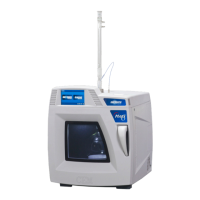45
Appendix A: GlassChem 20 Vessels
Operating Parameters
Parameters GlassChem 20
Vessel Volume 20 mL
Minimum Working Volume 3 mL
Maximum Working Volume 14 mL
Maximum Control Temperature 180 ºC
Minimum Ramp Time 5 min
Maximum Operating Pressure 200 psi
Power
1-4 Vessels: 500 W
5- 10 Vessels: 1000 W
11 - 24 Vessels: 1800 W
Temperature Control Type Fiber Optic probe
Recommended Stir Bar Teon coated Micro or “ea”
Vessel Pyrex
Thermowell Sapphire
Ideal Chemistry Organic, inorganic, or teaching laboratories
Supplemental Data
Temperature and pressure data for some common solvents has been compiled as a reference for use with these
vessels. Each of these tests was performed with 10 mL of the solvent in each of six vessels. The MARS was
programmed to heat to 180 °C or 200 psi, whichever came rst, over a 5 minute period, and then was held at the
set temperature and/or pressure for 5 minutes.
Solvent Temperature Max (°C) Pressure Max (psi)
Acetone 160 200
Acetonitrile 180 152
Dichloroethane 180 168
Dichloromethane* 135 200
Dimethylformamide (DMF) 180 20
Dimethylsulfoxide (DMSO) 180 9
Ethanol 165 200
Ethyl Acetate* 180 134
Hexanes* 180 183
Methanol 150 200
N-Methylpyrrolidinone (NMP) 180 21
Tetrahydrofuran (THF)* 203 263
Toluene** - -
Water 180 148
* Does not reach temperature or pressure setpoint within 5 minute ramp. Contact CEM Corporation before using
any low absorbing solvents.
WARNING
**The temperature and pressure of tetrahydrofuran rise rapidly as it reaches 180 °C therefore it is not
recommended to take tetrahydrofuran above 150 °C.

